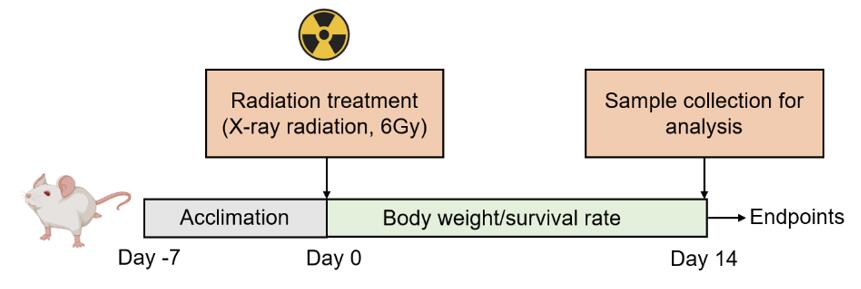- You are here: Home
- Disease Models
- Oncology Models
- Radiotherapy-Related Disease Models
- Acute Radiation Syndrome (ARS) Model
Disease Models
- Oncology Models
-
Inflammation & Autoimmune Disease Models
- Rheumatoid Arthritis Models
- Glomerulonephritis Models
- Multiple Sclerosis (MS) Models
- Ocular Inflammation Models
- Sjögren's Syndrome Model
- LPS-induced Acute Lung Injury Model
- Peritonitis Models
- Passive Cutaneous Anaphylaxis Model
- Delayed-Type Hypersensitivity (DTH) Models
- Inflammatory Bowel Disease Models
- Systemic Lupus Erythematosus Animal Models
- Asthma Model
- Sepsis Model
- Psoriasis Model
- Atopic Dermatitis (AD) Model
- Scleroderma Model
- Gouty Arthritis Model
- Carrageenan-Induced Air Pouch Synovitis Model
- Carrageenan-Induced Paw Edema Model
- Experimental Autoimmune Myasthenia Gravis (EAMG) Model
-
Cardiovascular Disease Models
- Surgical Models
- Animal Models of Hypertension
- Venous Thrombosis Model
- Atherosclerosis model
- Cardiac Arrhythmia Model
- Hyperlipoidemia Model
- Doxorubicin-induced Heart Failure Model
- Isoproterenol-induced Heart Failure Model
- Arterial Thrombosis Model
- Pulmonary Arterial Hypertension (PAH) Models
- Heart Failure with Preserved Ejection Fraction (HFpEF) Model
-
Neurological Disease Models
- Alzheimer's Disease Modeling and Assays
- Seizure Models
- Parkinson's Disease Models
- Ischemic Stroke Models
- Acute Spinal Cord Injury (ASCI) Model
- Traumatic Brain Injury (TBI) Model
- Hypoxic-Ischemic Encephalopathy (HIE) Model
- Tourette Syndrome (TS) Model
- Amyotrophic Lateral Sclerosis (ALS) Model
- Huntington's Disease (HD) Model
- Intracerebral hemorrhage (ICH) Models
- Pain Models
- Metabolic Disease Models
- Liver Disease Models
- Rare Disease Models
- Respiratory Disease Models
- Digestive Disease Models
-
Urology Disease Models
- Cisplatin-induced Nephrotoxicity Model
- Unilateral Ureteral Obstruction Model
- 5/6 Nephrectomy Model
- Renal Ischemia-Reperfusion Injury (RIRI) Model
- Diabetic Nephropathy (DN) Models
- Passive Heymann Nephritis (PHN) Model
- Adenine-Induced Chronic Kidney Disease (CKD) Model
- Kidney Stone Model
- Doxorubicin-Induced Nephropathy Model
- Orthopedic Disease Models
- Ocular Disease Models
- Skin Disease Models
- Infectious Disease Models
Acute Radiation Syndrome (ARS) Model
Creative Bioarray offers comprehensive services to evaluate the efficacy and elucidate the mechanisms of action of your innovative therapeutic agents within our well-established models of Acute Radiation Syndrome (ARS). Our expertise enables you to explore and address the critical clinical needs that remain unmet for patients affected by ARS, thus advancing your drug development efforts and contributing to the improvement of patient care in this challenging therapeutic area.
ARS, commonly known as radiation sickness or radiation poisoning, occurs when an individual is exposed to high levels of ionizing radiation over a short period. This condition presents as an acute illness that can significantly impact three critical body systems: the bone marrow, the gastrointestinal tract (GI-ARS), and the cardiovascular/central nervous system. Currently, the treatment for ARS primarily focuses on supportive care, highlighting the urgent need for the development of additional Medical Countermeasures (MCMs). Therefore, the use of animal models is essential in the search for new therapeutic strategies to combat ARS.
 Fig. 1 Subsyndromes of acute radiation syndrome. Whole-body radiation doses above approximately 0.7 Gy (in humans) result in serious radiation injury, with the hematopoietic system being affected at the lower dose range. Above 10 Gy, damage to the gastrointestinal system is observed in addition to the hematopoietic system damage. Above 50 Gy, serious damage to the central nervous system also occurs. As indicated in the figure, cell therapies may provide benefits to patients with H-ARS and/or GI-ARS but are unlikely to benefit patients with CNS-ARS. ARS, acute radiation syndrome. H-ARS, hematopoietic ARS. GI-ARS, gastrointestinal ARS. CNS-ARS, central nervous system ARS. (Christy et al. 2024)
Fig. 1 Subsyndromes of acute radiation syndrome. Whole-body radiation doses above approximately 0.7 Gy (in humans) result in serious radiation injury, with the hematopoietic system being affected at the lower dose range. Above 10 Gy, damage to the gastrointestinal system is observed in addition to the hematopoietic system damage. Above 50 Gy, serious damage to the central nervous system also occurs. As indicated in the figure, cell therapies may provide benefits to patients with H-ARS and/or GI-ARS but are unlikely to benefit patients with CNS-ARS. ARS, acute radiation syndrome. H-ARS, hematopoietic ARS. GI-ARS, gastrointestinal ARS. CNS-ARS, central nervous system ARS. (Christy et al. 2024)
Our Acute Radiation Syndrome (ARS) Model
- Animal Species
Rat
- Modeling Method
After acclimation, mice are treated with an X-ray radiation dose of 6Gy to induce ARS model.
 Fig. 2 Modeling method of Acute Radiation Syndrome (ARS) Model
Fig. 2 Modeling method of Acute Radiation Syndrome (ARS) Model
- Endpoints
- Survival rate
- Body weight
- Blood cell count
- Histology analysis
- qPCR or Western blot
- Other customized endpoints
Quotation and Ordering
Creative Bioarray is a leading research partner that specializes in providing a diverse range of rodent disease models and comprehensive services with professional expertise. In addition to our extensive collection of well-characterized models, we also offer customized model services tailored to each specific project. If you are interested in our services, please do not hesitate to contact us at any time or submit an inquiry to us directly.
Reference
- Christy, B.A., et al. Cell Therapies for Acute Radiation Syndrome. International journal of molecular sciences, 2024, 25(13): 6973.
For research use only. Not for any other purpose.

